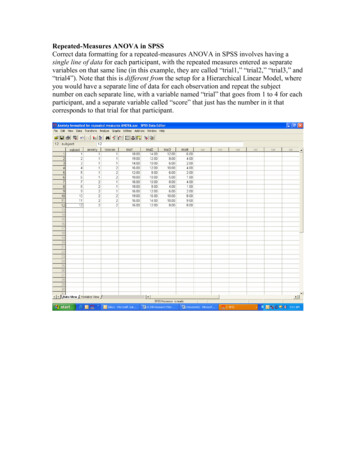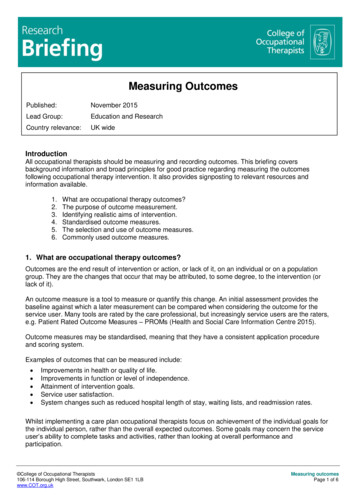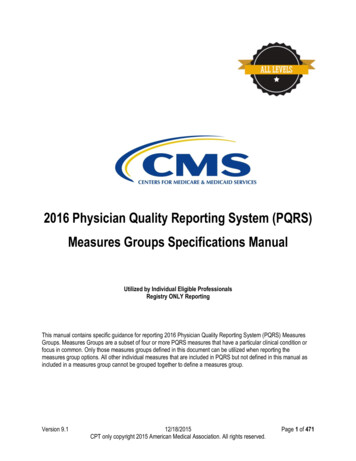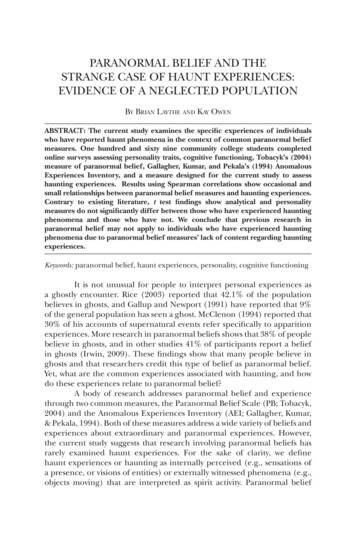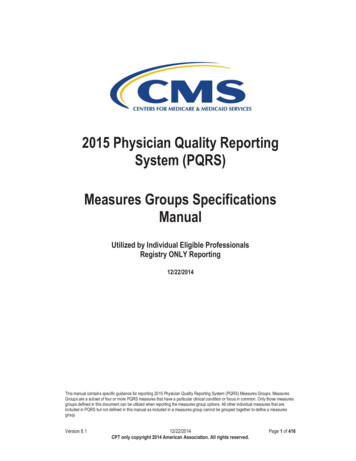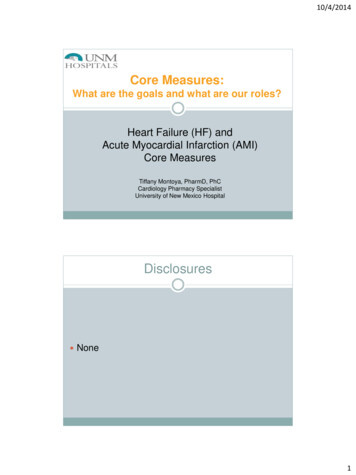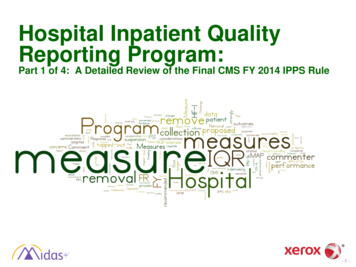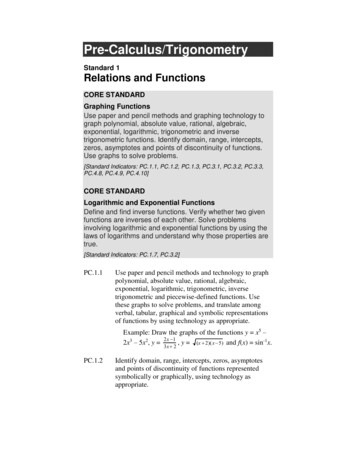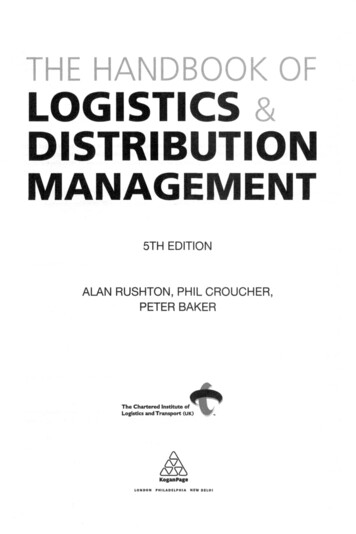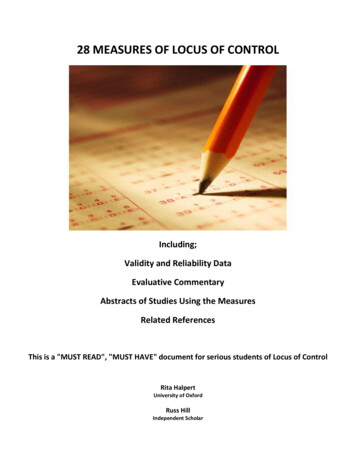
Transcription
28 MEASURES OF LOCUS OF CONTROLIncluding;Validity and Reliability DataEvaluative CommentaryAbstracts of Studies Using the MeasuresRelated ReferencesThis is a "MUST READ", "MUST HAVE" document for serious students of Locus of ControlRita HalpertUniversity of OxfordRuss HillIndependent Scholar
The Locus of Control Construct’s Various Means of Measurement:A researcher’s guide to some of the more commonly used Locus of Control scalesCopyright 2011 by Russ HillISBN 978-0-9833464-3-2WILL TO POWER PRESS, Beach Haven, NJAll rights reserved. No part of this book may be reproduced (except for inclusion in reviews), disseminatedor utilized in any form or by any means, electronic or mechanical, including photocopying, recording, or inany information storage and retrieval system, or on the Internet (World Wide Web) without writtenpermission from the author or publisher.For more information please visit: /Academics/Internal Control1
For Mum and Pup, as usual.2
Acknowledgements:I would like to thank everyone who took time to read over and edit thisbook: Megan Humphreys (all the way from Kenya), Michelle Ball (takingtime from her own graduate work), Karl Halpert (Pup!), and AlbertKleine (who stopped what he was doing a million times at the cue: “CanI ask you a question when you have a sec?”).I would like to thank Kristin Lane for always answering her emails. Evenwhile on Sabbatical. Even during holidays.I would like to thank the authors of the scales I have included, forresponding to my emails, providing their scales and other articles, andcorrecting any misinterpretations I had of their work. The collaborationof minds is what research is all about!I would especially like to thank Russ Hill, for keeping me in academiaduring my year between schools, for feeding me ideas and then lettingme run with them, and for being ever-positive about who I am andwhat I am doing.3
CONTENTSINTRODUCTION 6GENERAL MEASURES .8James Internal-External Locus of Control Scale .8Rotter Internal-External Locus of Control Scale .10Levenson IPC Scale .13Reid-Ware Three-Factor Internal-External Scale . .17Multidimensional Multiattributional Causality Scale . 21HEALTH MEASURES 24Multidimensional Health Locus of Control 24Drinking Locus of Control Scale .29Mental Health Locus of Control Scale and the Mental Health Locus of Origin Scale .32The Alcohol Responsibility Scale 35Diabetes Locus of Control Scale .38The Depression Locus of Control Scale .40Headache-Specific Locus of Control Scale .41Spiritual Health Locus of Control Scales .44Oral Health Locus of Control Scale .46AGE-SPECIFIC MEASURES .52Bialer-Cromwell Children’s Locus of Control Scale .52Crandall Intellectual Achievement Responsibility Questionnaire .54Nowicki-Strickland Locus of Control Scales 58Stanford Preschool Internal-External Scale .65Academic Locus of Control Scale .68Children’s Health Locus of Control Scale 70PARENTAL MEASURES .74Parental Locus of Control Scale . 74Fetal Health Locus of Control Scale .77Parental Health Belief Scales 79Furnham Parental Locus of Control Scale 814
MISC. MEASURES .84Teacher Locus of Control Scale and the Locus of Control Scale for Teachers . .84Economic Locus of Control Scale .88Prison Locus of Control Scale 91Dag and Haceteppe Locus of Control Scale . 92Traffic Locus of Control Scale .93GLOSSARY .955
INTRODUCTIONA person’s Locus of Control is where that person places the primary causation of events in his or her life. Isa poor grade on an exam due to poor study habits or the inadequacy of the professor? Or perhaps youwere fated to fail the class? Does a car accident occur because you weren’t paying attention or becauseothers need to learn how to drive? Locus of Control theory evolved from Bandura’s Social Learning Theory,which posits that observed and imitated behaviors are either reinforced through reward or extinguishedthrough punishment. Locus of Control falls on a continuum, with those who believe that their life is largelycontrolled by outside forces (externals) falling on one end of the spectrum while those who believe that byand large they control their own lives (internals) falling on the other end. As I have discovered in myresearch, locus of control can be used to predict things from psychological well-being to health behaviors,from academic and economic success to reaction to hardships.If it seems obvious that a person’s Locus of Control can be a driving influence on personality and behavior,you and I are in the same boat. If you are interested in using this information to change your own or other’sbehavior, this may not be the document you are looking for. I suggest you take a look atteachinternalcontrol.com, and explore some of the suggestions provided by Russ Hill’s recent book TeachInternal Locus of Control.If you are interested in researching Locus of Control and exploring the ways in which it does and does notinfluence personality and behavior, this is what you are looking for. Please read on.This publication is meant to be a starting point for researchers. In short, it contains a list of some of themore commonly used Locus of Control scales. For each of the scales, I address who wrote the scale, what itis used for, and links to validity studies, critiques, and studies that have implemented the scale in their ownresearch. It is my intention that individuals could use this document to determine the scales they wish toexplore. In addition, I have provided enough references to begin a literature search. If you are looking forextreme detail, particularly statistics, you will not find it here1. However, you will find links to thatinformation. Nothing in this document is exhaustive, and it is not meant to be an end point. Rather, I intendit to foster the beginning of your research.I also intend for it to paint a picture of the complexity of the construct. Such a simple idea, that yourperception of the work affects how you react to it, has been grasped by many researchers who have takenit in a million directions. Scales range from targeting the general population to individuals who experiencefrequent headaches. Research papers focus on mental health, physical health, social interactions, parentalstrategies, academic and economic success, creativity and everything in between. It was my reaction while1If you are looking for more detail, here are two good sources:Lefcourt, H. M. (Ed.). (1981). Research with the Locus of Control construct: Volume 1: Assessment methods. New York, NY:Academic Press Inc.Furnham & Steele (1993). Measuring Locus of Control: A critique of general, children's, health- and work-related Locus of Controlquestionnaires. British Journal of Psychology, 84, 443-4796
writing the book to be amazed at the nuances of the concept, and it is my hope to transfer that wonder toyou.When possible, I have included the full scales in the document. This is for you to get an idea for the layoutand contents of the scale. If you wish to use the scale in your research, it is always best to get the originalfrom the authors, which is why I do not include scoring information in this document. When abstracts areavailable for a study, I have provided a link. Documents that are not linked do not have free readilyavailable abstracts, but they can be found through professional search engines such as EBSCO.I have attempted to contact the creators of each scale. This was not always possible, as sometimes contactinformation could not be found. If you have created a scale that is in this document and I have notcontacted you, I encourage you to write to me. I am interested in hearing from you, and I am open tosuggestions.I encourage my casual readers to contact me as well. Have I forgotten to include a scale you think I shouldhave? Did you come across a study you would like to see here? Let me know! As the body of Locus ofControl Research is always growing and evolving, I want this document to grow and evolve as well. Let meknow what you notice. Let me know what you think.Best wishes for your research!-Rita Halpertfeedback.locusofcontrol@gmail.com7
GENERAL MEASURESJames Internal-External Locus of Control ScaleWilliam Homer James (1963)The James Internal-External Locus of Control Scale is one of the first devised measures of Locus of Control. James wasa student of Julian Rotter, whose social learning theory influenced the development of Locus of Control as aconstruct. Unlike the Rotter Locus of Control scale in which participants are forced to choose between twostatements, the James scale is a Likert-type scale in which participants rate how well a statement could be applied totheir own thinking. In James’s scale, the ratings range from 0 (strongly disagree) to 3 (strongly agree). This measurecontains 60 items, half of which are filler questions. There is a shortened version (Dixon 1976), in which some filleritems are altered or eliminated. All items on the James scale are worded from an external point of view (see below).James developed this scale in an unpublished doctoral dissertation while studying under Rotter. The abstract for thisdissertation is not readily available.JAMES INTERNAL-EXTERNAL LOCUS OF CONTROL SCALEFateWars between countries seem inevitable despite efforts to prevent them.Some people seem born to fail while others seem born for success no matter what they do.I feel that many people could be described as victims of circumstances beyond their control.I have usually found that what is going to happen will happen, regardless of my actions.I don’t believe that a person can really be a master of his fate.There’s not much use in worrying about things what will be, will be.LuckIt is usually true of successful people that their good breaks far outweigh their bad breaks.Many times I feel that we might just as well make many of our decisions by flipping a coin.Getting a good job seems to be largely a matter of being lucky enough to be in the right place at theright time.A great deal that happens to me is probably just a matter of chance.It isn’t wise to plan too far ahead because most of things turn out to be a matter of good or bad fortuneanyhow.When things are going well for me I consider it due to a run of good luck.Most people don’t realize the extent to which their lives are controlled by accidental happenings.Most of the disappointing things in my life have contained a large element of chance.Success is mostly a matter of getting good breaks.I think that life is mostly a gamble.Personal ControlI feel that I have little influence over the way people behave.Success in dealing with people seems to be more a matter of the other person’s moods and feelings at the timerather than one’s own actions.Many times I feel that I have little influence over the things that happen to me.Sometimes I feel that I don’t have enough control over the direction my life is taking.8
Powerful OthersIt is difficult for ordinary people to have much control over what politicians do in office.It seems many times that the grades one gets in school are more dependent on the teacher’s whims than onwhat the student can really do.Excerpt from the James Internal-External Scale, as found in Borich and Paver, 1974.Borich and Paver (1974) warn that this measure does not test well for convergent or discriminant validity and suggestthis as a possible reason as to why studies that test Locus of Control often produce inconsistent findings (in the samepaper, Borich and Paver fail to find reliable validity in the Levenson Internal, Powerful Others and Chance Scale, theNowicki Strickland Locus of Control Scale and the Rotter Internal External Locus of Control Scale). Dixon (1976)suggests that the “sledgehammer” approach taken by this scale (to measure Locus of Control as a general construct,rather than one that is situation-specific) is not the most valuable, and that specific scales for specific situations(academics, health, etc.) should replace the more general scales.This scale is not widely used. A search of Academic Search Alumni Edition, Academic Search Complete, ERIC, HealthSource - Consumer Edition, Health Source: Nursing/Academic Edition, MEDLINE, Mental Measurements Yearbook,PsycARTICLES, PsycCRITIQUES, Psychology and Behavioral Sciences Collection, PsycINFO, and GoogleScholar with keywords “James Internal External Locus of Control Scale”, produced only 5 results. The following is a short list of studieswhich have used the James Internal-External Locus of Control Scale:- Horak and Slobodzian (1978) used the James Internal-External Locus of Control Measure to investigate theeffects of low-structure versus high-structure classes on college students.- In France, Syrotuik and D’arcy (1982) found that while Locus of Control does not seem to directly influencelevels of stress in response to work, it does seem to relate to reactions to said stress.- Srinivasan and Tikoo (1992) investigated individuals purchasing cars and found internals generally did moreresearch before purchase than externals.References:Borich, G. D. & Paver, S. W. (1974). Convergent and discriminant validity of the locus of control construct. ReportResearch; Tests/QuestionnairesDixon, D. N. (1976). Dimensionality of three adult, objective locus of control scales. Journal of PersonalityAssessment, 40, 310-319.Horak, W. J. & Slobodzian, K. A. (1978). The effects of locus of control and method of presentation on pre-serviceteacher’s achievement. Proceedings from the Annual Meeting of the National Association for Research in ScienceTeaching, Toronto: CanadaSrinivasan, N. & Tikoo, S. (1992). Effect of locus of control on information search behavior. Advances in ConsumerResearch, 19, 498-504.Syrotuik, J. M. & D'arcy, C. (1982). Occupational stress, locus of control and health among men in a prairieprovince. Canadian Journal of Behavioral Science, 14, 122-133.9
Rotter Internal-External Locus of Control ScaleJulian Rotter (1966)Julian Rotter is credited for introducing the concept of Locus of Control. His work was largely based off the work ofAlbert Bandura, who developed the social learning theory. Rotter explains that humans can interpret events as beingeither a result of one’s own actions or external factors. He goes on to suggest that whether or not people believe asituation or event is under their own control will influence their reward expectancy and behavior. Rotter developed a23-item scale to assess whether a person has a tendency to think situations and events are under their own controlor under the control of external influences. This scale is a forced-choice paradigm in which a person chooses betweenan internal or external interpretation. Unlike many scales that were developed later, Rotter’s scale was not designedto investigate specific domains (e.g. academic domains, health domains etc.) but to give somewhat weakpredictability of a person’s interpretation across all domains. In other words, while Rotter believed that Locus ofControl could vary based on circumstance, he also felt that people could trend toward internality or externality as apersonality trait, and his scale was designed to assess this more general situation.Sample from the Rotter Internal-External Locus of Control Scale:1.a. Children get into trouble because their patents punish them too much.b. The trouble with most children nowadays is that their parents are too easy with them.2.a. Many of the unhappy things in people's lives are partly due to bad luck.b. People's misfortunes result from the mistakes they make.3.a. One of the major reasons why we have wars is because people don't take enoughinterest in politics.b. There will always be wars, no matter how hard people try to prevent them.4.a. In the long run people get the respect they deserve in this world.b. Unfortunately, an individual's worth often passes unrecognized no matter how hard hetries.5.a. The idea that teachers are unfair to students is nonsense.b. Most students don't realize the extent to which their grades are influenced by accidentalhappenings.A sample of Rotter’s Internal-External Locus of Control Scale, as found LOC.pdfThe Rotter scale is used extensively and has been validated in many situations, such as for use over time (Lang &Tiggemann 1981) in high school students (Zerega et al 1975), and in Chinese samples (Tong & Wang 2006).On the other hand, Borich and Paver (1974) suggest that the Rotter scale (as well as other Locus of Control scales)may not be measuring what they claim to be measuring. Kestenbaum and Hammersla (1976) warn that the filleritems in the Rotter scale are not necessary and do not deter participants from answering questions in a sociallydesirable way. They stress that ideally, in a forced choice paradigm, the options should hold equal social desirability,something they claim the Rotter scale fails to do. Hoffmann and Schenk (1985) claim to have made a scale that makesRotter’s scale appear to be “unfit” for use in the measurement of Locus of Control. Dixon, McKee and McRae (1976)suggest that scales for specific domains may be of more use in research than general scales, such as the Rotter scale.Levenson (1973), as well as Reid and Ware (1973) argue against the unidimensionality of the measure, and whileLocus of Control is largely regarded today as being a multidimensional construct, Rotter’s measure continues to bewidely used.The following is a short list of studies that have used the Rotter Internal-External Locus of Control Scale:10
----Baron and colleagues (1974) used the scale to add evidence to the finding that internals respond better tointrinsic (self-discovered) feedback for success while externals responded to extrinsic (verbally administered,in this paradigm) feedback for success.Bozorgi (2009), in a study of Iranian students, revealed that Locus of Control did not affect grade pointaverage in this sample.Burgess and Hamblett (1994) did not find a significant difference in Locus of Control between smokers, nonsmokers, and ex-smokers in their sample. However, when they reran the analysis on only the nurses in theirsample they did find a difference in Locus of Control orientation between smokers and non-smokers.Kesici (2008) found that internal teachers scored higher for “democratic values” than externals.Breet, Myburgh, and Poggenpoel (2010) in a South African sample of boys, determined that internal Locus ofControl correlated with lower levels of aggression, while external Locus of Control correlated with higherlevels of aggression.Cavaiola and Strohmetz (2010) found that internal alcoholics were more receptive to treatment-relatedinformation than external alcoholics.Deniz, Tras, and Aydogan (2009) found that, in their sample, Locus of Control was influenced by theadaptability and general mood of the participants.Mink and Watts (1973) developed a program to shift Locus of Control in students from more external tomore internal.This list is not exhaustive, as the Rotter scale is highly used. A search of Academic Search Alumni Edition, AcademicSearch Complete, ERIC, Health Source - Consumer Edition, Health Source: Nursing/Academic Edition, MEDLINE,Mental Measurements Yearbook, PsycARTICLES, PsycCRITIQUES, Psychology and Behavioral Sciences Collection, andPsycINFO revealed 2,186 results.Julian Rotter requested that his scale not be published in this document. However, it can be found online for yourreview. I personally respect the wishes of the authors discussed. Therefore, I suggest that if you would like to use thescale for a study, obtain permission from the author. Julian Rotter can be reached through Eleanor n, R. M., Cowan, G., Ganz, R. L. & McDonald, M. (1974). Interactions of Locus of Control and type ofperformance feedback: Considerations of external validity. Journal of Personality and Social Psychology, 30, 285-292.Borich, G. D. & Paver, S. W. (1974). Convergent and discriminant validity of the Locus of Control construct. ReportResearch; Tests/QuestionnairesBozorgi, S. (2009). On the relationship between Locus of Control and grade point average of the Iranian AzadUniversity EFL students. Online Submission: 28 pagesBreet, L., Myburgh, C. & Poggenpoel, M. (2010). The relationship between the perception of own Locus of Controland aggression in adolescent boys. South African Journal of Education, 30, 511-526.Burgess, C. & Hamblett, M. L. (1994). Application of the Rotter scale of internal-external Locus of Control todetermine the difference between smokers, non-smokers and ex-smokers in their general Locus of Control. Journalof Advanced Nursing, 19, 699-704.Cavaiola, A. A. & Strohmetz, D. B. (2010). Perception of risk for subsequent drinking and driving related offensesand Locus of Control among first-time DUI offenders. Alcoholism Treatment Quarterly, 28, 52-62.Deniz, M. E., Tras, Z. & Aydogan, D. (2009). An investigation of academic procrastination, Locus of Control, andemotional intelligence. Educational Sciences: Theory and Practice, 9, 623-632.Dixon, D. N. (1976). Dimensionality of three adult, objective Locus of Control scales. Journal of PersonalityAssessment, 40, 310-319.Furnham & Steele (1993). Measuring Locus of Control: A critique of general, children's, health- and work-relatedLocus of Control questionnaires. British Journal of Psychology, 84, 443-479Hoffmann, M. & Schenk, J. (1985). The logic of operationalization of the locus-of-control concept of Rotter:Examination of the bipolarity of internal external control. Diagnostica, 31, 93-10411
Kesici, S. (2008). Democratic teacher beliefs according to the teacher's gender and Locus of Control. Journal ofInstructional Psychology, 35, 62-69.Kestenbaum, J. M. & Hammersla, J. (1976). Filler items and social desirability in Rotter's Locus of Control scale.Journal of Personality Assessment, 40, 162-168.Lange, R. V. &Tiggemann, M. (1981). Dimensionality and reliability of Rotter I-E Locus of Control scale. Journal ofPersonality Assessment, 45, 398-406Levenson, H. (1973). Reliability and validity of the I, P, and C scales- A multidimensional view of Locus of Control.Paper presented at the American Psychological Association Convention: Montreal, Canada.Mink, O. G. & Watts, G. E. (1973). Reality therapy and personalized instruction: A success story. Paper Produced forthe U.S. Department of Health Education and Welfare.Reid, D. & Ware, E. E. (1973). Multidimensionality of internal-external control: Implications for past and futureresearch. Canadian Journal of Behavioral Science, 5, 264-271.Rotter, J. (1966). Generalized expectancies for internal versus external control of reinforcement, PsychologicalMonographs, 80 (1), Whole No. 609.Tong, J. & Wang, L. (2006). Validation of Locus of Control scale in Chinese organizations. Personality and IndividualDifferences, 41, 941-950.Zerega, W. D. et al. (1975). Stability and concurrent validity of the Rotter internal-external Locus of Control scale.Submitted to the Social and Rehabilitation Service (DHEW), Washington: DC.12
Levenson IPC ScaleHanna Levenson (1973)The Levenson scale was created out of a need to distinguish multiple dimensions within the external side of the Locusof Control continuum. Rather than rating people as simply external, the Levenson scale also investigates whether thisexternality is attributed to chaos/chance or to powerful others, such as political leaders, parents or God. Thus, theIPC scale distinguishes between three factors:InternalityPowerful OthersChanceLevenson claims five important distinctions between her scale and Rotter’s scale:1. The Levenson scale does not employ the forced-choice format of the Rotter scale, and instead uses a Likerttype rating system, which produces cleaner data.2. The scale asks the participant to interpret their own specific experience, rather than that of the generalpopulation.3. The Levenson scale uses less ambiguous wording.4. The scale is set up such that items for each different subscale are similar to the questions in the other twosubscales. For instance, if an item from the powerful other scale involves leadership, the chance and internalscales will also include an item about the leadership.5. There is extremely low social desirability bias in the Levenson scale.This scale was validated by its creator (Levenson 1972), who found that participants who rated high on the C scaleshared traits that could not be distinguished by the I or P scales, thus confirming the usefulness of themultidimensional approach. In a follow-up study, Levenson’s (1973) data showed that the split of externality intomultiple dimensions was justified. Levenson (1974) also conducted a study in which anti-pollution activism wasdifferent for those scoring high on the P scale, compared to the C scale. Loas, Dardennes, Dhee-Perot and others(1994) found the scale to be reliable and valid in a study they conducted with a French translation. Rossier andcolleagues (2002) also support the validity of the French translation of Leveson’s scale.The Levenson I, P, and C Scales1.2.3.4.5.6.7.8.9.10.11.12.13.14.15.Whether or not I get to be a leader depends mostly on my abilityTo a great extent my life is controlled by accidental happeningsI feel like what happens in my life is mostly determined by powerful peopleWhether or not I get in to a car accident depends mostly on how good of a driver I amWhen I make plans, I am almost certain to make them workOften there is no chance of protecting my personal interests from bad luck happeningWhen I get what I want, it’s usually because I am luckyAlthough I might have good ability, I will not be given leadership responsibility without appealing to thosepositions of powerHow many friends I have depends on how nice a person I amI have often found that what is going to happen will happenMy life is chiefly controlled by powerful othersWhether or not I get into a car accident is mostly a matter of luckPeople like myself have very little chance of protecting our personal interests when they conflict withthose of strong pressure groupsIt’s not always wise for me to plan too far ahead because many things turn out to be a matter of good orbad fortuneGetting what I want requires pleasing those people above me13
16. Whether or not I get to be leader depends on whether I am lucky enough to be in the right place at theright time17. If important people were to decide they didn’t like me, I probably wouldn’t make many friends18. I can pretty much determine what will happen in my life19. I am usually able to protect my personal interests20. Whether or not I get in a car accident depends mostly on the other driver21. When I get what I want, it is usually because I worked hard for it.22. In order to have my plans work, I make sure that they fit in with the desires of people who have powerover me23. My life is determined by my own actions24. It’s chiefly a matter of fate whether or not I have few friends or many friends.The Levenson I, C, and P scales, as found in Lefcourt, H. M. (1981).Locus of Control is thought by many researchers to be a multidimensional construct. The IPC scale has been adaptedinto many other scales, such as the Multidimensional Health Locus of Control Scale and the Fetal Health Locus ofControl Scale. It has also been translated into various languages, such as French (see above), Dutch, Chinese, andPersian.On the other hand, Riordan (1981) administered Levenson’s scale and Rotter’s scale to South African students, andwhile Rotter’s scale was found useful in this population, the author did not endorse the usefulness of Levenson’sscale. Riordan suggests a reevaluation of the usefulness of Levenson’s scale, citing that it was changed for thepurpose of his study from a Likert-type format to an agree/disagree format. Riordan considers the possibility that thiscould have altered the usefulness of the scale.The following is a brief list of studies that have used Levenson’s IPC scale:----Roddenberry & Renk (2010) found higher externality scores (in both the P and C scales) to correlate positivelywith higher stress levels.Culver and Morgan (1977) reported that while there was no significant relationship between readingachievement and Locus of Control using Rotter’s scale, reading achievement was negatively correlated withthe chance dimension of Levenson’s scale.Kelly and colleagues (1994) used the scale to determine whether or not the Desired Control Measure wasactually measuring Locus of Control.Kneipp and Gadzella (1990) found the C and P scales to correlate negatively with creativity.Lamanna (2001) discovered in a sample of women that emotional intelligence and internal Locus of Controlare positively correlated and both serve as a protective factor against depression.In an interesting study, Kennedy, Lynch and Schwab (1998) used t
3 Acknowledgements: I would like to thank everyone who took time to read over and edit this book: Megan Humphreys (all the way from Kenya), Michelle Ball (taking
